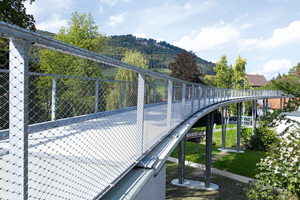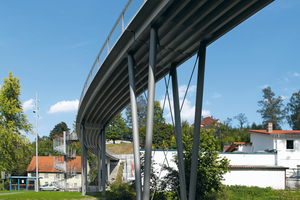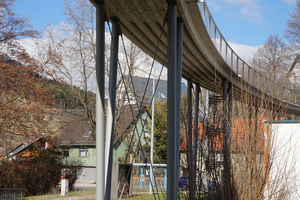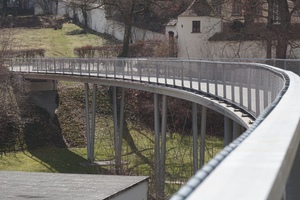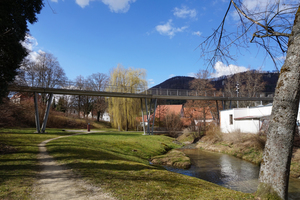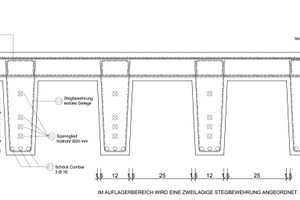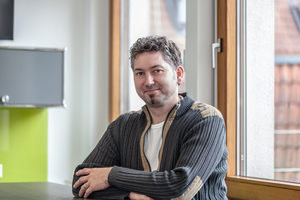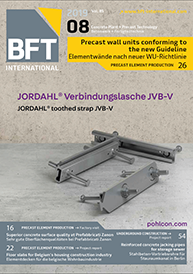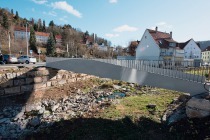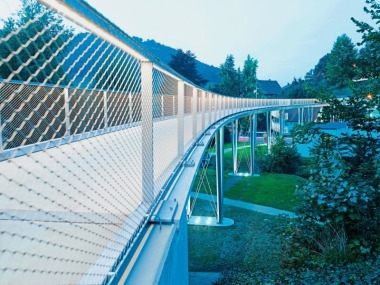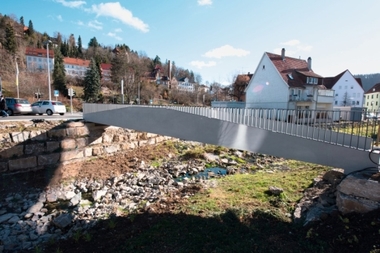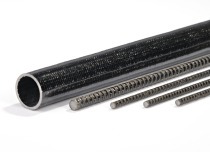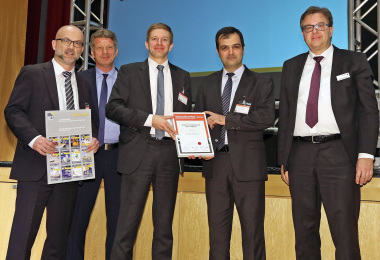Durability of textile-reinforced bridges –
an interim assessment
New construction methods are often viewed with a very critical eye. One of the numerous questions, which must also be raised with regard to glass fiber-reinforced and carbon-reinforced bridges, is: “How durable is the system?” One of the first bridges was built in Albstadt in 2010, almost ten years ago – a good time for an interim assessment.
In Albstadt-Lautlingen in the Swabian Jura, a pedestrian bridge made of reinforced concrete was past its prime. It displayed visual defects – such as rust stains – and posed a hazard to road traffic. Pieces of concrete had fallen on a federal road running under the bridge, for example, impairing traffic safety. As a consequence, the bridge had to be demolished and replaced by a new one. Since the textile industry has a long tradition in this area of Germany, the municipality of Albstadt was very open-minded on the subject of textile-reinforced concrete.
After a feasibility study showed that it was possible to build the 97-m long bridge using glass fiber-reinforced concrete, the clients decided to put this concept into practice. As building with glass fiber-reinforced concrete had not been tested for extended periods at that time and required individual approval, the responsible parties proved in two ways at once that the bridge was capable of withstanding the loads: numerically and by means of extensive component testing. In order to be able to correctly assess the current condition of the bridge, it is useful to take a look at the materials used, design details and component testing.
Textile-reinforced concrete
The use of textile-reinforced concrete was, and still is, out of the ordinary in bridge construction. However, this construction method offers a major advantage: the lack of susceptibility to corrosion of the non-metal reinforcement. For the bridge in Lautlingen, this allowed the concrete cover to be reduced to a thickness of only 1.5 cm. A comparable reinforced-concrete structure would have required a cover of at least 5 cm. In addition to that, the combination of textile-reinforced concrete and prestressing without bond permitted a slenderness of 1:35 to be achieved, which is quite extraordinary for concrete structures.
Contrary to conventional bridge construction, in which a layer of asphalt is applied on top of the concrete surface to protect the steel reinforcement against corrosion, this was not required for the Lautlingen project. A concrete mix design was therefore developed which meets high requirements in terms of surface quality and workability and complies with the specifications of concrete strength class C50/60. Due to the harsh winters in Albstadt with large amounts of snow, large quantities of de-icing salts are used. In addition, the bridge is cleared of snow in winter regularly using a snow-clearing vehicle. For the bridge designers, this meant two things at once: they needed to factor in the mechanical abrasion caused by the snow plough while at the same time ensuring that the concrete complied with exposure class XF4. With regard to abrasion, the designers assumed, being on the safe side, that the concrete surface would be reduced by one centimeter within 80 years due to the effects of mechanical action.
Current condition of the bridge
In summary, it can therefore be stated that, during the design stage, the engineers took into account both the characteristics of building with textile-reinforced concrete and the specific requirements of the demanding climate conditions prevailing in the Swabian Jura. As a result, the bridge is in very good condition today after almost ten years of use. It goes without saying that, since the reinforcement of glass fiber mesh does not corrode, there are no visible rust stains, let alone spalling, as was the case with the old reinforced-concrete bridge. The use of de-icing salt has not caused any damage to the bridge to this day. The surface of the pedestrian path is impeccable, as is the stability of the entire structure.
Nico Köllnick, who is employed by Breinlinger Ingenieure Hoch- und Tiefbau GmbH and inspected the Lautlingen bridge in accordance with DIN 1076 on behalf of Albstadt’s municipal authorities, has reached the same conclusion. He says that “all bridges have to be inspected regularly once a year for obvious defects and damage. This process involves looking at the critical spots, such as the column bases, and checking as to whether they show any irregularities.” After inspecting the Lautlingen bridge, Mr. Köllnick reached the conclusion: “The bridge is in excellent overall condition.” A statement that should please the town of Albstadt and its citizens as well as all those interested in building with glass fiber reinforcement. For the impeccable condition of the bridge in Lautlingen – despite being exposed to high climate-induced stresses – shows that glass fiber-reinforced engineering structures have a promising future. The prerequisites are, of course, a similarly good and meticulous design as that for the bridge in Lautlingen as well as careful construction.
During research for this text, Claudia El Ahwany talked to Nico Köllnick on behalf of BFT International. The civil engineer, who holds the VFIB certificate for the inspection of engineering structures according to DIN 1076, inspected the glass fiber-reinforced bridge in Albstadt-Lautlingen.
BFT International: Mr. Köllnick, what were your assignments in connection with the bridge in Lautlingen?
N. Köllnick: Engineering consultants Breinlinger from Tuttlingen were commissioned to inspect several bridges in Albstadt and check them for visual damage. This included the textile-reinforced concrete pedestrian bridge in the Lautlingen district. The check was performed as a thorough, extended visual inspection in accordance with DIN 1076 without the use of inspection equipment or devices. As part of the visual inspection, we also checked the functional elements of the bridge such as the bearings, articulation joints, expansion joints and anchorage.
BFT International: Who was the client?
N. Köllnick: We were commissioned by the Office for Construction and Service of the Civil Engineering Department, that is, by the municipality of Albstadt.
BFT International: Which parts of a bridge are typically susceptible to damage?
N. Köllnick: Wherever surface water containing de-icing salt comes into contact with steel-reinforced concrete either directly or as spray mist. This may be on the bases of the columns and abutments. It may also be on the surface of the bridge caps. In addition, the drainage areas and movable parts of a bridge are susceptible to damage when becoming permeable to water over time.
BFT International: How does it come about?
N. Köllnick: Deposits and buildups of gritting agents containing de-icing salt promote the ingress of chlorides into the pavements and surfaces of uncoated reinforced concrete, as well as into the unprotected reinforced concrete through open or permeable joints or sealings. In addition to extensive corrosion under oxygen reduction due to carbonation of the concrete cover, depassivation may also be initiated by chlorides. Water plays a crucial role in this process as the means of transport in the concrete. Depending on the moisture content and porosity of the concrete, chlorides may be transported by means of capillary action but also by means of diffusion. The chlorides cause local destruction of the passive layer and corrosion of the steel. Experience has shown that reinforcement corrosion in the reinforced concrete elements will increase rapidly as a result of chlorides. Due to progressive corrosion, reductions in cross-section and therefore impaired bearing capacities are to be expected.
BFT International: Were these damages visible on the bridge?
N. Köllnick: No, there was no indication of reinforcement corrosion on the Lautlingen textile-reinforced concrete bridge.
BFT International: Given the age of the bridge, what was its overall condition?
N. Köllnick: The overall visual condition of the bridge was very good.
BFT International: Assuming that the bridge will be exposed to the same stresses as before for the next five years, what would you estimate its condition to be in five years’ time?
N. Köllnick: The overall condition of the bridge will not change in the next five years, provided that regular structural maintenance is performed in the same way as it is done for other bridges.
BFT International: In your opinion, what are the advantages and disadvantages of glass fiber-reinforced concrete in bridge construction?
N. Köllnick: The advantages of glass fiber-reinforced concrete are that only a thin concrete cover is required, thus reducing the thickness and dead weight of the structural elements. Since the reinforcement is resistant to corrosion, the structural elements are more durable. The disadvantage is that building with textile-reinforced concrete still requires a significant effort as there are neither applicable guidelines and standards nor national technical approvals. Currently, each use requires verification and approval on a case-by-case basis.
BFT International: What else should be mentioned in connection with the Lautlingen bridge?
N. Köllnick: It represents an innovative development for engineering and building construction that certainly is and will be a good way forward regarding the durability of structural concrete elements.

